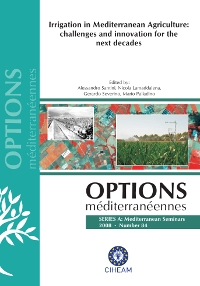| Article précédent | p. 135-141 | Article suivant |
The evapotranspiration of crop protected by windbreak
The mechanisms with which windbreaks modify the microclimatic components and the evapotranspiration have been studied through laboratory testing (wind-tunnel), observations in the field (in Australia and in USA) and crop models. The extrapolation of the results of these studies does not allow for the quantification of their effective benefit in crop water consumption. This study proposes modifications to the Penman-Monteith formula to allow for calculation of the water requirements of wheat and bean in the presence of windbreaks. The microclimatic data were recorded in an experimental field protected by a windbreak of Cupressus arizonica L., positioned in a perpendicular direction to the prevailing winds (N). These results were used to correct the reference evapotranspiration formula (ET0) and the crop coefficients (Kc). With these corrections, the action of windbreaks on ET and water consumption were simulated. The simulations highlighted that, during 2000, the reduction of ET near the windbreak was 115mm for wheat and 95mm for bean. Different heights of the windbreak were simulated on a 1ha bean plot to quantify the contribution to effective water savings. The simulation highlighted that 8m high barriers offered the maximum water savings, estimated by 36 per cent greater than consumption for an unprotected plot.
Les mécanismes par lesquels les brise-vent modifient les composantes microclimatiques ainsi que l'évapotranspiration ont été étudiés au moyen de tests en laboratoire (soufflerie), d'observations sur le terrain et de modèles de culture. Ce travail suggère de modifier la formule de Penman-Monteith (FAO, 56) pour permettre le calcul des besoins en eau du blé et des haricots en présence de brise-vent. Les données microclimatiques ont été enregistrées sur un terrain expérimental protégé par un brise-vent de Cupressus arizonica L. placé en position perpendiculaire par rapport aux vents dominants (N). Les résultats ont été utilisés pour corriger la formule d'évapotranspiration de référence (ETref) et les coefficients culturaux (Kc). Grâce à ces corrections, l'action des brise-vent sur l'ET et la consommation d'eau ont été simulées. Les simulations ont mis en évidence qu'en 2000, la réduction de l'ET près du brise-vent était de 115 mm pour le blé et de 95 mm pour les haricots. Au contraire, pendant la saison 1996, il n'y a pas eu de variations de l'ET à n'importe quelle distance du brise-vent. Différentes hauteurs de brise-vent ont été simulées sur un champ de haricots de 1 ha pour quantifier sa contribution à l'économie effective d'eau. La simulation a mis en évidence que des barrières de 8 m de hauteur assurent une économie d'eau maximale, estimée à 36 pour cent par rapport à la consommation d'un champ non protégé.
- [ Afficher ]
- [ Télécharger ]
- [ Exporter la citation ]
Vous pouvez télécharger la citation au format :
- [ Imprimer ]
-
Mots-clés
ARIDOCULTURE, BRISE-VENT, EFFICIENCE D'UTILISATION DE L'EAU, EVAPOTRANSPIRATION, MICROCLIMAT, MODELE DE SIMULATIONCiter cet article
Campi P., Palumbo A.D., Mastrorilli M. The evapotranspiration of crop protected by windbreak. In : Santini A. (ed.), Lamaddalena N. (ed.), Severino G. (ed.), Palladino M. (ed.). Irrigation in Mediterranean agriculture: challenges and innovation for the next decades. Bari : CIHEAM, 2008. p. 135-141. (Options Méditerranéennes : Série A. Séminaires Méditerranéens; n. 84). International Conference on Irrigation in Mediterranean Agriculture: Challenges and Innovation for the Next Decades, 2008/06/17-18, Naples (Italy). http://om.ciheam.org/om/pdf/a84/00800959.pdf



